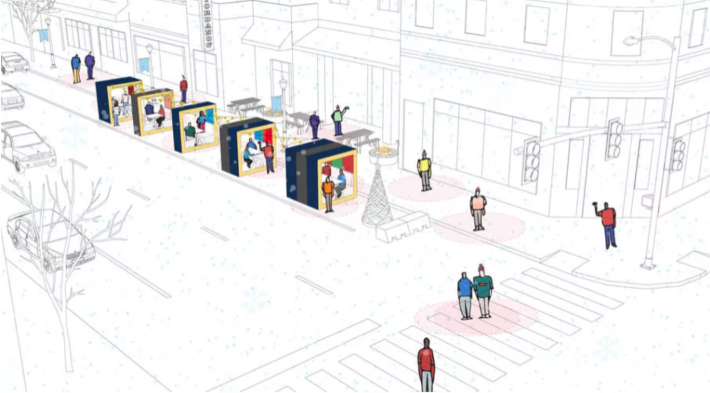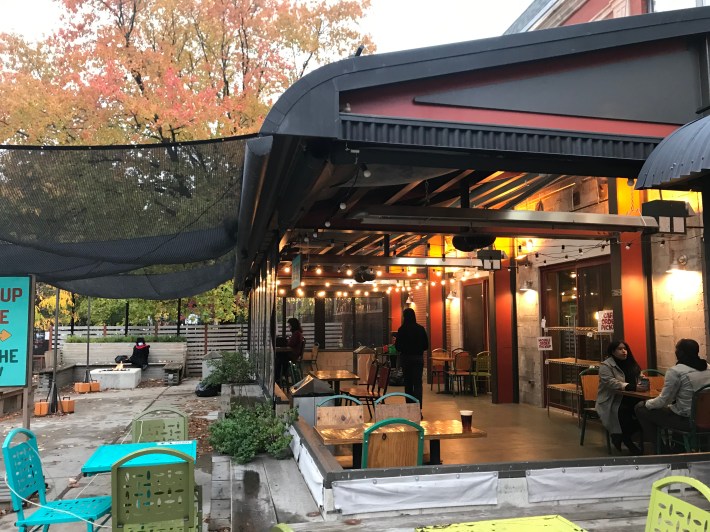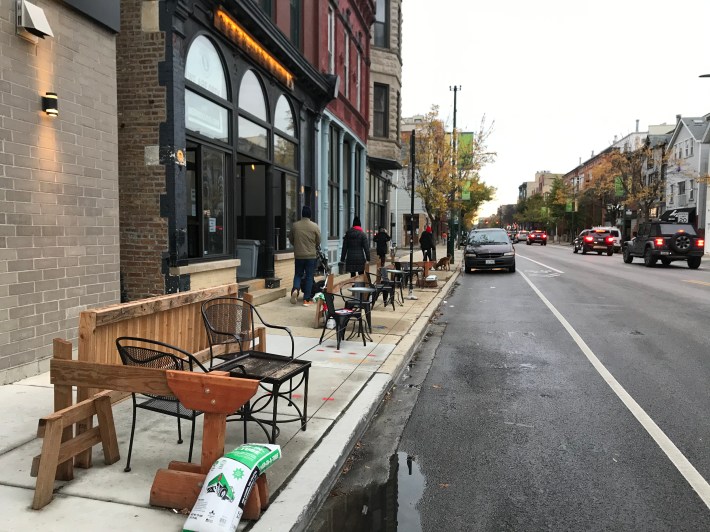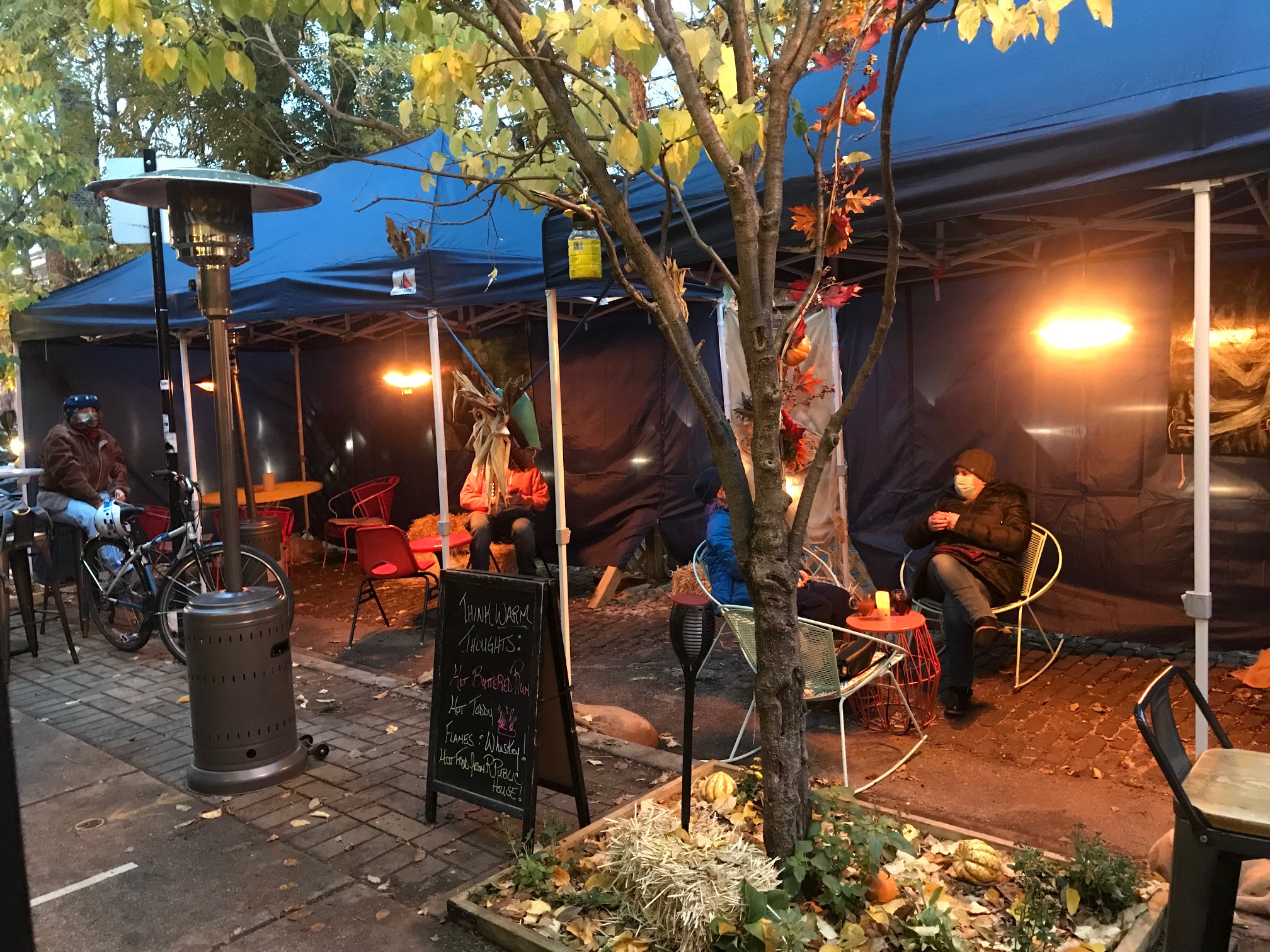Note that Streetsblog Chicago does not guarantee the safety of the outdoor restaurant and bar setups shown. Readers should make decisions about whether and/or where to dine or drink in public during the pandemic based on info and advice from public health experts, plus their own comfort level and perspective on whether outdoor service is beneficial for employees.
Chicago hospitality workers and business owners got some sobering news today. After Mayor Lori Lightfoot banned indoor service for bars without kitchens last week, today Governor J.B. Pritzker announced he was prohibiting all indoor bar and restaurant service in response to our city's troubling seven-day COVID-19 testing positivity rate of 7.8 percent.
That may be a prudent strategy to help mitigate the kind of wide-scale loss of life we saw in Illinois last spring. Epidemiologists generally say it's a bad idea to hang out in indoor public spaces for non-essential purposes during the airborne respiratory pandemic.
But that's cold comfort to the thousands of local bar and restaurant employees and entrepreneurs whose livelihoods will be profoundly impacted by the policy. If this was a more civilized country like New Zealand, the government would be paying them a fair stipend to close their establishments during the crisis.
This situation is also bad news for all of us who treasure Chicago's diverse, vibrant dining and drinking scene, one of the best things about living here. We seem to be standing on the brink of a mass extinction of local restaurants and bars, which would be awful for our city's economy.

Lightfoot and the departments of Business Affairs and Consumer Protection and Transportation, which regulate outdoor seating, should be bending over backwards to prevent that from happening by making it easy for businesses to turn car space, such as parking lanes and lots, into customer space. Experts say dining, drinking, and socializing in the presence of non-household members is much safer when it's done outside.
As such, Chicago officials need to need to throw away the rule book. If there's any way that street space can be used for safer outdoor winter seating, they need to nix the permit fees, and use a machete to cut through the red tape.
The good news is that the Lightfoot administration has already shown admirable leadership in this department. Chicago's Cafe Streets program, which pedestrianized dozens of roadways this summer to make room for socially-distanced dining, was wildly successful. The city's contest to brainstorm ideas for winter outdoor dining, such as replacing parking spots with individual "Cozy Cabins" was also a great idea.

But winter outdoor dining solutions don't need to be futuristic, like the Buckminster Fuller-inspired geodesic domes that have been installed on a car-free block of Fulton Market in the West Loop. (While these are nifty, due to limited airflow I wouldn't recommend hanging out inside them with non-household members, and restaurant workers shouldn't be required to enter these structures while customers are present.)
There's plenty of potential for hospitality businesses to make up for lost indoor seating through simpler means, such as event tents set up in patios, parking lots, sidewalks, and parking lanes, open on one side for ventilation and warmed by commercial heaters.

But city officials can't stand in their way during these desperate times. For example, I've heard about local aldermen dragging their feet about signing off on repurposing parking lanes for tented seating, even during an era when parking demand is at historic lows. (Yes, the city's hated parking meter deal is also a potential obstacle, but if necessary the businesses or the local Special Service Area could compensate the concessionaire for any loss of meter revenue.)

On Southport Avenue retail corridor in Lakeview, a few businesses have taken over the entire sidewalk with outdoor seating, with various levels of ventilation. In these cases the parking lane has been converted into a pedestrian detour protected from drivers by Jersey barriers, which seems like a fine solution, as long as it's not too much of a hassle for people with mobility challenges. Ramps have been installed to accommodate people using wheelchairs.

The bottom line is that there are plenty of ways Chicago can help restaurants and bars survive this extremely challenging period when cold-weather outdoor seating is their only option -- if Mayor Lightfoot and other city officials are willing to be flexible, generous, and proactive to help them out.




